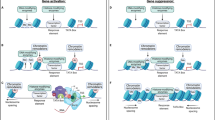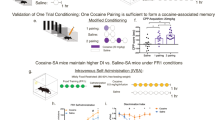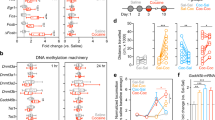Abstract
Acute exposure to cocaine transiently induces several Fos family transcription factors in the nucleus accumbens1, a region of the brain that is important for addiction2,3. In contrast, chronic exposure to cocaine does not induce these proteins, but instead causes the persistent expression of highly stable isoforms of ΔFosB4,5,6. ΔFosB is also induced in the nucleus accumbens by repeated exposure to other drugs of abuse, including amphetamine, morphine, nicotine and phencyclidine7,8,9,10. The sustained accumulation of ΔFosB in the nucleus accumbens indicates that this transcription factor may mediate some of the persistent neural and behavioural plasticity that accompanies chronic drug exposure1. Using transgenic mice in which ΔFosB can be induced in adults in the subset of nucleus accumbens neurons in which cocaine induces the protein, we show that ΔFosB expression increases the responsiveness of an animal to the rewarding and locomotor-activating effects of cocaine. These effects of ΔFosB appear to be mediated partly by induction of the AMPA (α-amino-3-hydroxy-5-methyl-4-isoxazole) glutamate receptor subunit GluR2 in the nucleus accumbens. These results support a model in which ΔFosB, by altering gene expression, enhances sensitivity to cocaine and may thereby contribute to cocaine addiction.
This is a preview of subscription content, access via your institution
Access options
Subscribe to this journal
Receive 51 print issues and online access
$199.00 per year
only $3.90 per issue
Buy this article
- Purchase on SpringerLink
- Instant access to full article PDF
Prices may be subject to local taxes which are calculated during checkout





Similar content being viewed by others
References
Nestler,E. J. & Aghajanian,G. K. Molecular and cellular basis of addiction. Science 278, 58–63 (1997).
Koob,G. F. & Le Moal,M. Drug abuse: hedonic homeostatic dysregulation. Science 278, 52–58 (1997).
Wise,R. A. Drug-activation of brain reward pathways. Drug Alcohol Depend. 51, 13–22 (1998).
Hope,B. T. et al. Induction of a long-lasting AP-1 complex composed of altered Fos-like proteins in brain by chronic cocaine and other chronic treatments. Neuron 13, 1235–1244 (1994).
Hiroi,N. et al. FosB mutant mice: loss of chronic cocaine induction of Fos-related proteins and heightened sensitivity to cocaine's psychomotor and rewarding effects. Proc. Natl Acad. Sci. USA 94, 10397–10402 (1997).
Chen,J., Kelz,M. B., Hope,B. T., Nakabeppu,Y. & Nestler,E. J. Chronic Fos-related antigens: stable variants of deltaFosB induced in brain by chronic treatments. J. Neurosci. 17, 4933–4941 (1997).
Nye,H. E., Hope,B. T., Kelz,M. B., Iadarola,M. & Nestler, E J. Pharmacological studies of the regulation of chronic Fos-related antigen induction by cocaine in the striatum and nucleus accumbens. J. Pharmacol. Exp. Ther. 275, 1671–1680 (1995).
Nye,H. E. & Nestler,E. J. Induction of chronic Fos-related antigens in rat brain by chronic morphine administration. Mol. Pharmacol. 49, 636–645 (1996).
Pich,E. M. et al. Common neural substrates for the addictive properties of nicotine and cocaine. Science 275, 83–86 (1997).
Atkins,J., Carlezon,W. A., Chlan,J., Nye,H. E. & Nestler,E. J. Region-specific induction of ΔFosB by repeated administration of typical versus atypical antipsychotic drugs. Synapse 33, 118–128 (1999).
Furth,P. A. et al. Temporal control of gene expression in transgenic mice by a tetracycline-responsive promoter. Proc. Natl Acad. Sci. USA 91, 9302–9306 (1994).
Chen,J. et al. Transgenic animals with inducible, targeted gene expression in brain. Mol. Pharmacol. 54, 495–503 (1998).
Moratalla,R., Vallejo,M., Elibol,B. & Graybiel,A. M. D1-class dopamine receptors influence cocaine-induced persistent expression of Fos-related proteins in striatum. Neuroreport 8, 1–5 (1996).
Wolf,M. E. The role of excitatory amino acids in behavioral sensitization to psychomotor stimulants. Prog. Neurobiol. 54, 679–720 (1998).
Robinson, T E. & Berridge,K. C. The neural basis of drug craving: an incentive-sensitization theory of addiction. Brain Res. Rev. 18, 247–291 (1993).
Kalivas,P. W., Pierce,R. C., Cornish,J. & Sorg,B. A. A role for sensitization in craving and relapse in cocaine addiction. J. Psychopharmacol. 12, 49–53 (1998).
Carlezon, W. A. Jr et al. Regulation of cocaine reward by CREB. Science 282, 2272–2275 (1998).
Pennartz,C. M., Groenewege,H. J. & Lopes da Silva,F. H. The nucleus accumbens as a complex of functionally distinct neuronal ensembles: an integration of behavioural, electrophysiological and anatomical data. Prog. Neurobiol. 42, 719–761 (1994).
White,F. J., Hu,X. T. & Zhang,X. F. Neuroadaptations in nucleus accumbens neurons resulting from repeated cocaine administration. Adv. Pharmacol. 42, 1006–1009 (1998).
Bai,G. & Kusiak,J. W. Cloning and analysis of the 5′ flanking sequence of the rat N-methyl-D-aspartate receptor 1 (NMDAR1) gene. Biochim. Biophys. Acta 1152, 197–200 (1993).
Hiroi,N. et al. Essential role of the fosB gene in molecular, cellular, and behavioral actions of electroconvulsive seizures. J. Neurosci. 18, 6952–6962 (1998).
Myers,S. J., Dingledine,R. & Borges,K. Genetic regulation of glutamate receptor ion channels. Annu. Rev. Pharmacol. Toxicol. 39, 221–241 (1999).
Brene,S., Messer,C., Okado,H., Heinemann,S. F. & Nestler,E. J. Regulation of AMPA receptor promotor activity by neurotrophic factors. Soc. Neurosci. Abs. 23, 923 (1997).
Hollmann,M. & Heinemann,S. Cloned glutamate receptors. Annu. Rev. Neurosci. 17, 31–108 (1994).
Seeburg,P. H., Higuchi,M. & Sprengel,R. RNA editing of brain glutamate receptor channels: mechanism and physiology. Brain Res. Rev. 26, 217–229 (1998).
Carlezon, W. A. Jr et al. Sensitization to morphine induced by viral-mediated gene transfer. Science 277, 812–814 (1997).
Rocha,B. A. et al. Increased vulnerability to cocaine in mice lacking the serotonin-1B receptor. Nature 393, 175–178 (1998).
Peoples,L. L., Uzwiak,A. J., Guyette,F. X. & West,M. O. Tonic inhibition of single nucleus accumbens neurons in the rat: a predominant but not exclusive firing pattern induced by cocaine self-administration sessions. Neuroscience 86, 13–22 (1998).
Surmeier,D. J., Song,W. J. & Yan,Z. Coordinated expression of dopamine receptors in neostriatal medium spiny neurons. J. Neurosci. 16, 6579–6591 (1996).
Gerfen,C. R., McGinty,J. F. & Young,W. S. Dopamine differentially regulates dynorphin, substance P, and enkephalin expression in striatal neurons: in situ hybridization histochemical analysis. J. Neurosci. 11, 1016–1031 (1991).
Acknowledgements
We thank H. Nadim and P. Jatlow for performing serum cocaine measurements; A. Withers-Lowin for assistance with the Morris water maze; and A. Sangoram, N. Hiroi, A. Eisch, D. Russell, S. Numan and D. Wolf for helpful comments. This work was supported by grants (to E.J.N.) and a predoctoral NRSA fellowship (to M.B.K.) from the National Institute on Drug Abuse, and by the Abraham Ribicoff Research Facilities of the Connecticut Mental Health Center.
Author information
Authors and Affiliations
Corresponding author
Supplementary information
Rights and permissions
About this article
Cite this article
Kelz, M., Chen, J., Carlezon, W. et al. Expression of the transcription factor ΔFosB in the brain controls sensitivity to cocaine. Nature 401, 272–276 (1999). https://doi.org/10.1038/45790
Received:
Accepted:
Issue Date:
DOI: https://doi.org/10.1038/45790
This article is cited by
-
Key transcription factors mediating cocaine-induced plasticity in the nucleus accumbens
Molecular Psychiatry (2022)
-
Unveiling OASIS family as a key player in hypoxia–ischemia cases induced by cocaine using generative adversarial networks
Scientific Reports (2022)
-
Cell-type- and region-specific modulation of cocaine seeking by micro-RNA-1 in striatal projection neurons
Molecular Psychiatry (2022)
-
Oxycodone self-administration activates the mitogen-activated protein kinase/ mitogen- and stress-activated protein kinase (MAPK-MSK) signaling pathway in the rat dorsal striatum
Scientific Reports (2021)
-
Restraint Stress Potentiated Morphine Sensitization: Involvement of Dopamine Receptors within the Nucleus Accumbens
Neurochemical Research (2021)



